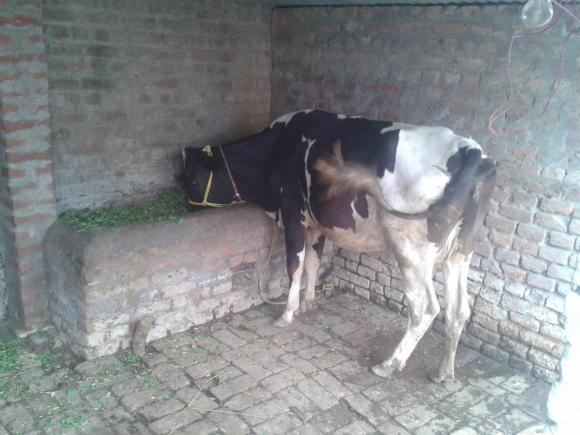-
About
- Our Work
- Get Involved
- Stay Updated
Non-Conventional Feedstuffs for Nutritional Security of Animal

India, a land of 1.31 billion human population and 512.05 million livestock population scattered in an area of 3.29 million sq. km. makes it one of the most crowded places on the planet. Among the large animal population, 37.28% are cattle, 21.23% buffaloes, 12.71% sheep, 26.40% goats and 2.01% pigs, which is one of the densest in terms of animal per unit of cultivated land.
Ruminants form the major proportion of all the livestock in India and it is a well established fact that these ruminants are “recyclers” which recycle feed into various valuable compounds like milk, meat, wool, hair, manure, etc which are of prime importance for human population and forms the very basis of innumerable food chains around the globe. But these animals also require nutrition to safeguard human nutrition.
India, a major player in livestock sector globally is falling short of feeds and fodder from time immemorial. The bulk of animal ration is guaranteed by feeding fodder both green and dry to the animals but the data suggests that only 4.4% of the available for fodder production. Similarly, the area under permanent pastures and cultivable wastelands is approximately 13 and 15 million hectares respectively. In India, during monsoons, there are ample feed resources. But for the remaining periods of the year, the animals have to be maintained on the crop residues or straws of jowar, bajra, ragi, wheat, barley, etc. either in the form of whole straw or bhusa, supplemented with some green fodder, or as sole feed. The present demand of fodder is more than 2500 million tons; on the contrary the present availability of fodder is even less than 1200 million tons, which alarms the livestock nutritionists to discover a new arena for endowing nutritional security on animals for optimum production.
Non-Conventional Feedstuffs
 Conventional feedstuffs; L-R Baggase, Alfafa, Dried mustard
Conventional feedstuffs; L-R Baggase, Alfafa, Dried mustardNon-conventional feedstuffs refer to all those feeds that have not been traditionally used in animal feeding and or are not normally used in commercially produced rations for livestock. Non-conventional feedstuffs include commonly, a variety of feeds from perennial crops and feeds of animal and industrial origin. The term non-conventional feedstuffs has been frequently used to describe such new sources of feedstuffs as pallet oil mill effluent and palm press fiber (oil palm by-products), single cell proteins, and feed material derived from agro industrial by-products of plant and animal origin. Poor-quality cellulosic roughages from farm residues such as stubbles, haulms, vines and from other agro-industrial by-products such as slaughter-house by-products and those from the processing of sugar, cereal grains, citrus fruits and vegetables from the processing of food for human consumption also comes under category of non-conventional feedstuffs.
These feedstuffs can be put to use for animal feeding as they provide no competition from their human counterparts. Mostly these are the byproducts which are obtained after the removal of main product for human use. The bran obtained by sieving wheat flour, bagasse obtained after removal of cane juice from sugarcane, sugarcane tops, maize bran, rice bran, rice husk, the mustard seed hulls or the stem of mustard plant after drying and treating it with molasses, etc which are in-edible for human population can be used for animal feeding. The ruminants being excellent recyclers can recycle such wastes and byproducts into valuable products.
With increasing demand for livestock products as a result of rapid growth in the world economies and shrinking land area, future hopes of feeding the animals and safeguarding their food security will depend on the better utilization of non-conventional feedstuffs which do not compete with human food. The situation is acute in numerous developing countries where chronic annual feed deficits and increasing animal populations are common, thus making the problem a continuing saga. Thus non-conventional feeds could partly fill the gap in the feed supply, decrease competition for food between humans and animals, reduce feed cost, and contribute to self-sufficiency in nutrients from locally available feed sources. It is therefore imperative to examine for cheaper non-conventional feed resources that can improve intake and digestibility of low quality forages. Feedstuffs such as fish offal, duckweed and kitchen leftovers (i.e., potato peel, carrot peel, onion peel, and cabbage leftover), poultry litter, algae, Leucaena leaf, local brewery and distillery by-products, sisal waste, cactus, coffee parchment and coffee pulp are commonly used in India, and could be invaluable feed resources for small and medium size holders of livestock.
The present day young farmers can make an optimum use of these feed resources by collecting such ingredients for their farms and feeding them to their animals. They can further advocate the use of these feeds to the local farmers and support them in gaining the first hand knowledge of these feedstuffs from various livestock extension agencies, thus providing nutritional security to animals.
Tags:About the author
Related Posts
Comments
No comments made yet. Be the first to submit a commentBy accepting you will be accessing a service provided by a third-party external to https://www.ypard.net/
Get in touch
Email: [email protected]
YPARD Global Coordination UnitHosted by AGRIDEA and the Czech University of Life Sciences Prague
Lausanne, Switzerland and Prague, Czech Republic - Our Work

 Conventional feedstuffs; L-R Baggase, Alfafa, Dried mustard
Conventional feedstuffs; L-R Baggase, Alfafa, Dried mustard